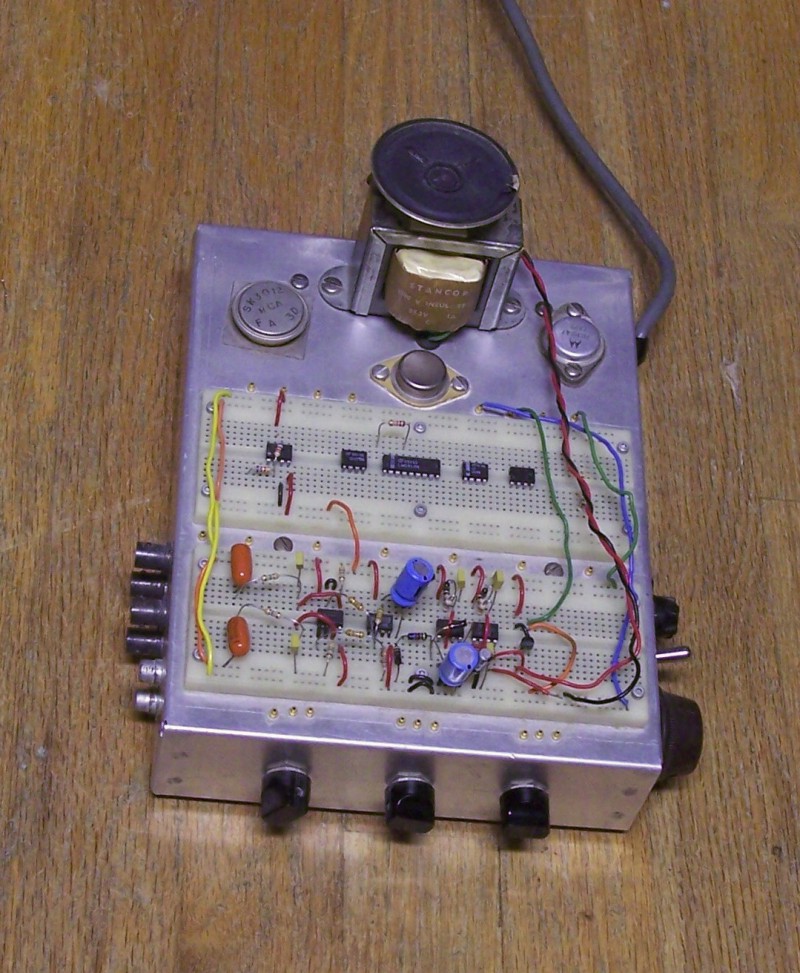
If you want to restore old radios you need the following.
Note: The first consumer transistor radios came out in the mid nineteen fifties. At this writing, 2006, that makes the oldest one 50 years old. Yep, they are almost antiques.
A transistor tester helps a lot but is not absolutely necessary. Many DMMs have a transistor beta readout.
- A small soldering iron.
- A solder removal tool.
- A Capacitor Tester that includes a leakage test.
- A DMM (Digital Multimeter).
- Depending on your age and the condition of your eyes, a magnifying glass.
A soldering iron.
You can't work on any electronics without one. The 20 and 25 watt kind for PC boards are what is recommended. If you can afford one a temperature controlled one is better.A solder removal tool.
Removing components from a PC board requires more than just heating the connection and pulling on the part from the other side. It is a certainty that the part will not come off whole and the chances of damaging the board are very high. There are a couple of ways to remove solder.One is a solder sucker. This is a special soldering iron with a rubber bulb and a hollow tip. The theory is that you heat the solder, squeeze the bulb, and when you release it the molten solder will be sucked up. In practice they never worked very well for me. If they work at all they leave too much solder behind to permit the lead to be removed from the hole.
There are vacuum pumps that use the same principle except they use a small electric pump to produce a continuous suction. I am told they work quite well but they are VERY expensive and I have never owned one.
There is a product that is sold under the names Solder-Wick and Chem-Wick. It consists of clean copper braid that has been coated with a soldering flux. While its use does require some practice, once you get the hang of it, it soaks up solder like the proverbial sponge and the part will literally fall out of the board.
You may have read in a magazine that braid from old shielded or coaxial cable can be used for this. If you are going to attempt this you need to buy a bottle of non-acid soldering flux. Even with that it probably won't work as well because the old wire has a thick coating of oxcide that can't be completely removed by the flux. Also the cost of the flux is so great there seems to be little or no money savings in doing it this way. You're gonna pay the man now or pay him later. You might as well go ahead and buy the Chem-Wick.
A Capacitor Tester.
There are capacitor testers and there are capacitor testers. The most common failure mode of capacitors in transistor circuits is to become leaky. Many digital capacitance meters on the market can be fooled and will still give you a reasonable reading even on a capacitor that is too leaky to be used in a circuit. A tester with a leakage test is a must.DMM DMMs are quite inexpensive these days and sometimes an electronics parts dealer will give them away with a 50 dollar order. There is just no excuse for not having one.
Transistor Tester
A transistor tester is somewhat of a luxury. Very handy and a time saver but not absolutely necessary. You can test a transistor using the diode check found on many DMMs. A good transistor shows a diode from base to collector, and another one from base to emitter. It shows open from emitter to collector in both directions for the 2 volt test voltage used in these meters.If you want to build the projects on this site you need the following.*
- A soldering iron.
- A breadboard.
- A power supply.
- An audio amplifier.
A soldering iron.
You can't work on any electronics without one. The 20 and 25 watt kind for PC boards are what is recommended. If you can afford one a temperature controlled one is better.Items 2, 3, and 4.
You can build items 2, 3, and 4, from the list above by following articles on this site.* If you would rather you can buy them on eBay.You could use the audio section in an All Japanese 6 by cutting the trace to the top of the volume pot and connecting the signal to top and bottom, ground.
A breadboard I built many years ago is pictured here. The sockets are still readily available. The power supply can now be built with much less complication as found elsewhere on this site.*

Luxury items
- High precision DMM.
- R F Signal Generator, Modulated.
- Sine wave oscillator.
- Harmonic distortion analyzer.
- Various low and high current power supplies.
- AC Voltmeter; voltage range down to 1 mV and frequency to 1 MHz or higher.
- Sine, Square, and Triangular wave function generator.
- Frequency counter.
- Q Meter.
- Impedance Bridge.
- Dual trace oscilloscope.
* If you happen to find this page early in its life some of the projects referenced won't be posted yet. Keep checking back, they are in the pipeline.
Thank you for visiting my page at Angelfire.
Please come back and visit again!This site begun July 27, 2006.
This page last updated July 29, 2006.